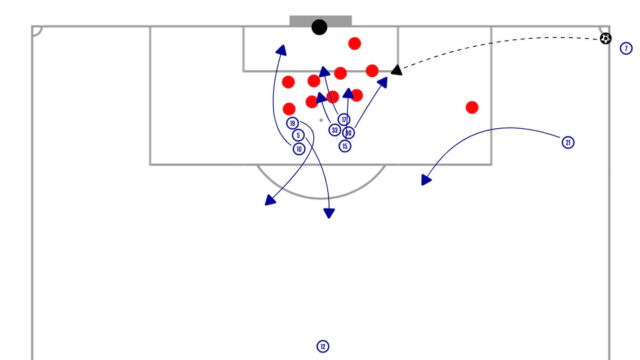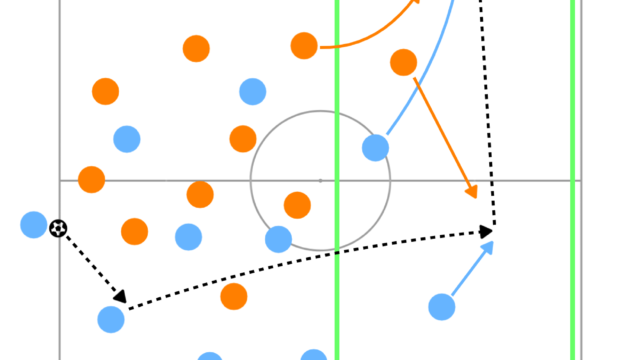How to Attack Corner Kicks in Football? [Tactical Analysis]
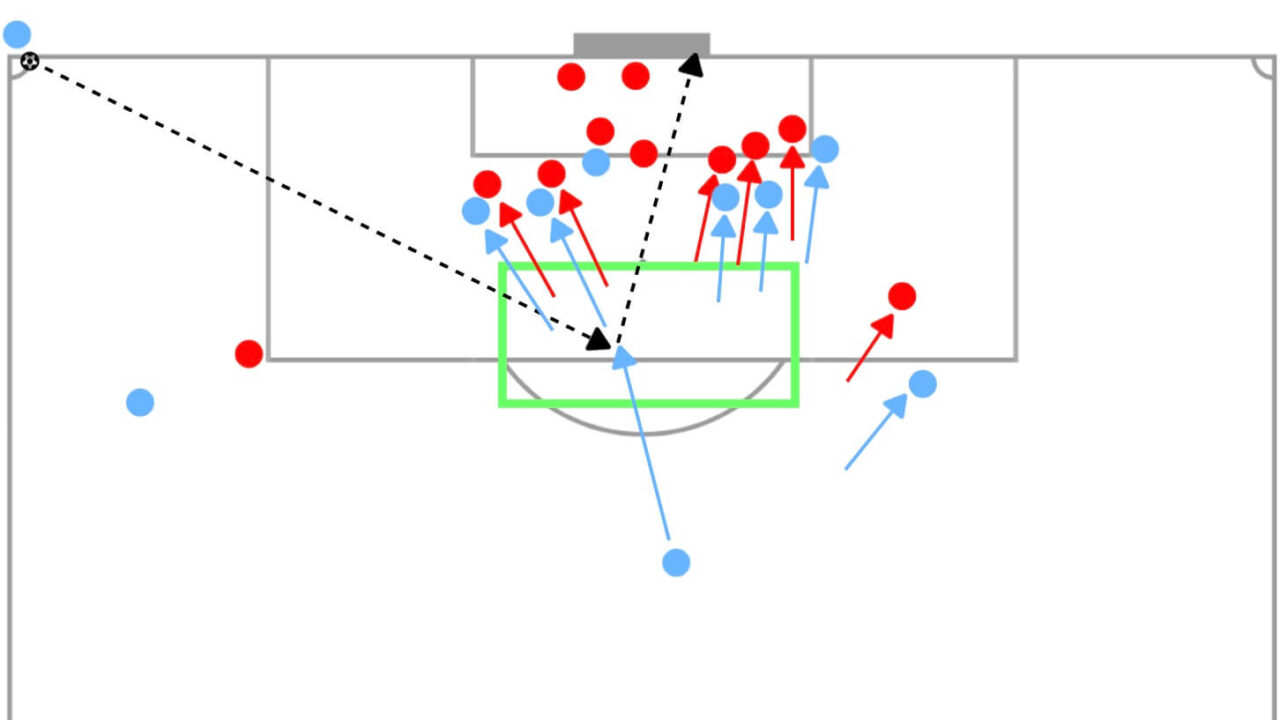
Introduction
It is obvious that the ability to score many goals from set pieces is important to win close games and ultimately titles. Even though there are many set pieces in football such as throw in or free kicks, corner kicks are extremely vital. This is because not only it can produce goal scoring opportunities, but also it is easy to organise. Unlike free kicks, corner kicks are always taken from the same areas in each side. Thus, every time same routine is repeated and it means how much it is practiced or how effectively it is organised make a difference.
When considering tactics about set pieces, attacking tactics are often altered depending on defending tactics. This is because changing defending tactics dramatically game by game can result in immature organisation due to the lack of time to train, so the defensive setups are hardly changed throughout a season. On the other hand, attacking tactics should be more flexible. Considering how to maximise the strengths of the attacking team and exploit the weaknesses of the defending team are crucial to score goals from set pieces. Thus, the attacking tactics depend on the opposition defending tactics.
Therefore, first step of planning attacking routine is analysing the opposition defending setup. How to defend corner kicks is already analysed in the article below, so I highly recommend you read this first. I hope you will enjoy it.
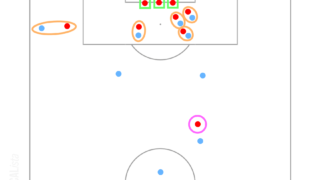
Attacking the First Post
No matter how to defend corner kicks, there are always some players defending the space around the first post. While the detail reason of this will be found in the article above, this is because mainly it is always an overloaded situation for defending teams and the space around the first post is the most dangerous area. In other words, it is extremely effective to attack that area if it is possible to beat the opposition first post guards.
In the Premier League this season (22-23), there is a team who always attack the first post area in all corner kicks. It is Tottenham Hotspur under an Italian set piece coach Gianni Vio. The detail will be found in the article below.
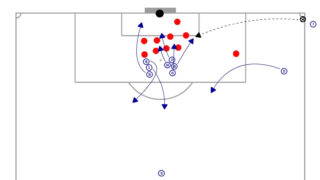
Then, as the first post guards defend the space zonally, it is the most important to consider where they position themselves. In many cases, they are in the square between the edge of the 6-yard box and the first post.

There are mainly two ways to plan attacking patterns to exploit the area around the first post. First one is, though this is the simplest one, analysing the vacant space and targeting there. The presence of the defender at the first post depends on if the ball is delivered by in-swing or out-swing, but realistically, scoring goals from the area closer to the goal line is harder than from the 6-yard line. Thus, it should be focused mainly how to beat the near post guard on the line of 6-yard box.
After analysing where the space is, then, it will be considered how to maximise the space. There are mainly two ways. If the near post guard is closer to the goal, blocking him/her to prevent stepping up to clear the ball. This blocking strategy will be one of the most common and important ideas. Usually, the player asked to block someone is a small player because it is not required to win aerial duels and it is wasteful to pick a strong player to just block someone.

Alternatively, if the defender at the first post is occupying the around edge of the 6 yard-box, dragging him/her out by running past the edge of the 6-yard box by pretending to head the ball in front of the near post guard or receive short corners will be a solution to open the space.

However, the decision of tracking the dummy attacker can vary in each team. Sometimes, the defender is taught not to follow that kind of movements and focus on staying there. If it is already analysed, blocking the near post guard from the back can be useful. This does not increase the space, but it helps the ball to be delivered successfully beyond the defender.
So far, how to maximise the vacated space was discussed. Another way to beat the near post guard is exploiting the weaknesses of zonal defending. Near post guard is a defender who prioritises to defend the space instead of marking the opposition player. And the strategies which will be examined here is how to overcome the characteristics of this zonal defending.
The detail of zonal defending will be discussed in the later chapter, but the key factor is using physical superiority. The first idea is getting one of the strongest attackers to compete with the near post guard in the air. The defenders at the first post are often small or tall but not good at aerial duels. Additionally, it is possible to analyse who will be there before the game because same players will defend at the first post in every game. Thus, attacking teams can plan who can beat the near post guard before the game. The second idea is using the blind side of the defenders. As their job is attacking and clearing the ball, they are focusing on the ball more than any opposition attackers. Therefore, popping out from the back of the near post guard to flick the ball can be an option to take an advantage at the first post.

When trying to flick the ball at the first post, it is also essential to get an attacker to arrive at the back post. Even if the ball is flicked successfully at the near side, it is often seen that it goes wide. However, if one of attackers is at the back post, the ball can be easily tapped in. Thus, it is important to decide who will attack the back post even when the ball is planned to be delivered to the first post.
Overall, against all types of defensive organisation, there are some defenders at the first post. Thus, it is worth considering how to attack the first post and this can give a team consistent chance throughout the season.
Attacking against Man Marking
In this chapter, how to exploit the weaknesses of man marking defensive tactics will be analysed. Man marking setups can be defined as the defensive structures which all attackers in the box are marked by defenders. Therefore, the positions of defenders depend on where attackers are except for the positions of a few defenders around the near post. Consequently, in attacking perspective, it is possible to create a free space in front of the goal intentionally. Then, if attackers can successfully lose their markers, they can have a chance of a free header in front of the goal. Thus, one of the most important factors is how to lose markers and there are mainly three options.
Screen
The first way to lose markers is using screen strategy. This is also known as ‘pick’ in basketball. This strategy will be performed in a pair of two or a group of a few attackers. In both cases, it is usually planned who will be a target attacker and who will set a screen to help him/her. Then, the target player uses the screen set by a teammate to prevent his/her marker from tracking him/her. By running around the screen, the player who set the screen can block the marker of the target attacker and free him/her from a tight marking.

If the screen is set by more than an attacker in a group, the probability of losing the marker successfully can be higher because the width of the screen becomes longer. It means if the marker wants to keep following the attacker, he/she needs to bypass longer distance than when a screen is set by a single player.

However, there is a disadvantage when a screen is set by a larger number of players. The players who set a screen cannot attack the ball because their job is blocking the opposition defenders. Thus, the more players set a screen, the less players can attack and head the ball. Consequently, as the number of players who can attack the ball becomes less, the ball needs to be delivered more precisely. Therefore, by trying to increase the probability of freeing a main attacker with a bigger screen, the better accuracy of the delivery will be required. On the other hand, if the taker of corner kicks is poor, the number of target attackers should be larger to meet the ball, while the probability of losing their markers will be low due to the lack of the number of players who can set a screen.
Split Movements
Another method to beat man marking is making split runs. One of the weaknesses of screening strategy was that the player setting a screen cannot attack the ball. On the other hand, in this split movements strategy, everyone can be a target attacker. Attackers positioned themselves in line or close each other and make a run towards each destination at the same time.

Unlike screen strategy, there is no intention to block the specific marker intentionally to make a spare attacker in front of the goal. However, thanks to the synchronised split movements, it is possible to create confusion among defenders and force them to misjudge who to follow. It is more difficult to create a chance of a free header than screen strategy, but synchronised runs can be enough to move earlier than the marker and make a moment to head the ball without any pressure. Additionally, all attackers can attack the ball so the ball does not need to be delivered as precisely as it should be when using screening strategy.
Individual Movements
Not only tactics as a team but also an individual movement is also important. No matter what strategy is utilised, it is vital to possess the ability to be unmarked. For example, using a dummy movement to disguise the opposition defender is effective.

Before running towards the destination, making a few steps to the opposite direction to disguise the marker can create a gap between them to head the ball away from pressure. This can be also useful even when performing screen strategy or split movements to create extra space. As an individual movement is the basic to lose the marker against man marking setups, it is vital to coach players how to disguise the opposition defender by himself/herself.
Overall, the key factor against man marking defensive setups is how to lose the marker as a team and individuals. As a team, screen strategy or split movements are useful to create a chance of a free header and as an individual, it is important to make a dummy movement to make an extra gap.
Attacking against Zonal Defending
In contrast to man marking setups, there is another strategy to defend corner kicks, which players defend space instead of marking the opposition attackers. Thus, defenders do not care about where the opposition attackers are and each defender only focuses on clearing the ball delivered to the allocated area. Of course, however, there are weaknesses of zonal defending and main three strategies will be discussed here.
Blocking
In zonal setups, it is possible to find a space to exploit between each defender. However, gaps between them are so tight and if the ball is delivered to one of those gaps, a defender can easily clear the ball. Therefore, blocking the defender who tries to clear the ball can help the main attacker to head the ball successfully.

This idea is very similar to the screen strategy discussed in the previous chapter. Thus, the weakness of the strategy is also similar. As the player who blocks the opposition defender cannot attack the ball, it requires the taker of corner kicks to deliver more precise ball towards the specific area. Additionally, unlike man marking, many defenders occupy the small area in front of the goal in zonal defending. Consequently, it is inevitable to have aerial duels even though blocking defenders. Therefore, it should be considered how to gain an advantage in aerial duels and it will be discussed next.
Physical Superiority
One of the strengths of zonal defending is that defenders are ready to attack the ball to clear it further. On the other hand, however, if the ball is delivered just above defenders, they cannot run up to jump higher and increase the power in an aerial duel. To maximise this possible advantage, running up from the distance to win the aerial duel and delivering the ball by out-swing can be beneficial.

The reason of the out-swing delivery is that the ball is curved towards the attacking player and away from the defender. Therefore, it will help the attacker to meet the ball and also increase the power of the header. As the space in front of the goal is more congested, it is important to help attackers to win aerial duels and those efforts can be useful. Of course, needless to say, getting the strongest attacker to run towards the weaker defender is the easiest tactic.
Back Post Area
Finally, another weakness of zonal defending is the back post area. This is because defenders are positioned in the central area and the back post area is often ignored or at least weaker defenders are defending there. Additionally, their focus is on the ball, so the back post area is the blind side for defenders. For those reasons, it is effective to deliver the ball to the back post area and head it back.

Against this delivery, the furthest defenders need to step back to deal with it. However, clearing the ball with running backwards is difficult and it is even possible to block them to prevent from stepping back. Additionally, all defenders need to turn their body angle, so the attackers in the middle are likely to be unmarked. Consequently, delivering the ball to the back post area is one of the most effective ways to beat zonal defending.
Attacking against Mix Marking
Between man marking and zonal defending, there is another type of setups, called mix marking. In mix marking, there are some players defending space while others marking some attackers. Thus, basically it is possible to plan attacking patterns based on the combination of man marking and zonal defending. For example, using screen strategy to be unmarked and also attack the back post area to exploit the weakness of zonal defending. Unlike man marking, however, not all attackers are marked, so there are some spare players. Thus, against mix marking, how to make the most of the spare attacker will be a specific strategy.

Overall, it is possible to combine the strategies of how to exploit the weaknesses of man marking and zonal defending when planning attacking tactics against mix marking. Additionally, the use of a spare attacker will be a specific tactic against mix marking.
Importance of Kickers
Obviously, the accuracy of the delivery is crucial. If you have a good set piece taker and a strong attacker, it becomes easier to score goals from set pieces, of course. Additionally, as it was mentioned earlier, how to use screen or blocking strategy depends on the accuracy of the delivery. If the ball can be delivered precisely, it is possible to let more players set a screen or block to free the one or two main strongest attackers in front of the goal. However, if the delivery is poor, it is required to let more players attack the ball to increase the probability of the ball found by an attacker. Thus, needless to say, the accuracy of the delivery is essential.
Additionally, the type of the delivery should be considered when planning attacking routines and there are in-swing, out-swing and straight delivery.
In-Swing
In-swing delivery is the ball curving towards the goal. This is effective when attacking the first post area because the ball needs to be flicked just slightly to make it difficult for the goalkeeper or defenders to react it. Additionally, defending teams need to have a defender at the near post to prevent the ball from going in the goal directly. It means the number of defenders who can defend the space around the ball side edge of the 6-yard box will decrease. Therefore, in-swing delivery is effective to attack the first post area.

Out-Swing
On the other hand, out-swing delivery is the ball curving away from the goal. Thus, there is almost no possibility that the ball goes in the goal directly from the corner. Consequently, some teams do not have a defender at the first post and increase the number of defenders around the near side edge of the 6-yard box. Therefore, it is difficult to attack the first post by out-swing delivery.

However, as it was mentioned in the chapter of zonal defending, out-swing delivery can be beneficial for attackers. The ball curving towards attackers can help them to win aerial duels or increase the power of the header.
Straight
It is rare to see the ball is delivered straight instead of being curved. However, it is effective when attacking the back post area or delivering the ball around the D to let one of attackers outside of the box take a volley. When attacking the back post, the ball will be often headed back to the space in front of the goal. In this situation, the ball needs to be delivered over defenders in front of the goal and driven straight balls are suitable. Additionally, when trying to deliver the ball to the D and letting one of the attackers outside of the box take a volley, the ball should not be curved to make it easier to take a shot. Thus, straight delivery is selected when doing so.
Overall, there are some characteristics for each type of delivery, but the benefit of type of delivery and the accuracy of the ball should be compared. If there are no good left-footed takers of set pieces but attacking the first post is the aim, should one of those left-footed poor players take corner kicks from the right corner to make it in-swing? Or, should the aim itself be changed and let a better right-footed player take it from the right side? This is the question which needs to be answered by each team. Therefore, the tactics of corner kicks should be unique and different in all teams.
Short Corners & Trick Patterns
When considering tactics of corner kicks, short corners or trick patterns are famous to be discussed. However, the possible problem is that they are only focusing on own movements and ignoring the opposition setups. The key is how to exploit their weaknesses and, in this chapter, how to use them properly is going to be discussed.
First of all, the advantage of short corners is going to be analysed. If there is no attacking player around the corner to play short, the only option for the taker is just delivering the ball into the box. Therefore, no defenders need to step out. However, if there is an attacking player around the corner to be played short, at least a defender needs to mark him/her. However, it is still 2v1 situation for an attacking team, so in this case, the attacking team can exploit the overload to progress the ball closer to the goal and then play it into the box.

To prevent this, another defender is required to step out to make it 2v2. If this happens, as in many cases one of the near post guards will apply pressure, the area in front of the goal will be less congested and especially the space around the first post will be opened.

This kind of short corners is effective against teams defending with zonal structure. One of the characteristics which can be seen in many teams with zonal defending is pushing the line up quickly against short corners. The aim of it is setting the offside line as high as possible and preventing the opposition attacking team from taking a shot from a cross before it happens by making it offside. However, by understanding this objective, it is possible to exploit the huge gap between the opposition back line and goalkeeper.

It is difficult for the attackers in the box to keep adjusting the offside line and also change the direction to run in behind with avoiding offside. However, the attacking player outside of the box originally to prepare for the second ball can easily avoid the offside trap and exploit the space in behind. Additionally, the player is often positioned in the blind side of defenders, so the attacker can be unmarked quite often. Thus, using short corners to let the opponent push the line up and exploiting the space in behind by the blind side run from the attacker outside of the box can be an effective way against zonal defending teams.
In terms of trick patterns, there are so many routines but some principles will be discussed here.
Against man marking setups, the key factor is how to move the opposition defenders away and create a space to take a shot. Mainly, keeping a space open or making a space will be options. The first one is the strategy to exploit their weakness which initial positions obey where attackers are.

Most of all attackers stay at the back post area and keep the near side empty. Then, one of the attackers moves towards the space and take a shot from an easy pass. In this case, it is also important to get an attacker to block the opposition near post guard to prevent the pass from being intercepted.
Instead of making the space open initially, it is also effective to create the space. As the opposition defenders will follow the attackers’ movements, if all attackers in the box move the same direction, there will be a huge space.

In this case, all attackers in the box make a run towards the goal line and leave the space around the D. Then, the spare player pops up there and takes a shot. The detail should be changed based on the opposition organisation, but they are the ideas of some trick patterns against man marking.
On the other hand, against zonal defending, it is difficult to create space inside of the box because the dangerous space is already covered by defenders. However, it means there is a space outside of the box. Thus, it is an effective routine to play a straight ball towards the edge of the box and take a first-time volley from there.

Overall, these short corners or trick patterns can lead a great opportunity to score goals and it is worth trying to do it in a game. However, all movements should depend on how the opposition team is defending and it cannot be ignored. Therefore, movements based on some principles are better than strict routines.
Thanks for reading. I hope you enjoyed this article.

